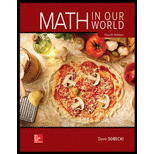
Concept explainers
At the beginning of a magic trick, The Great Mancini shuffles an ordinary deck of 52 cards as shown in Figure 11-6, and has the nearest person in the audience draw a single card. Using the
(a) A 10.
(b) A club.
(c) The ace of hearts.
(d) A 3 or a 5.
(e) A 6 or a spade.
(f) A queen or a club.
(g) A diamond or a club.
(h) A red king.
(i) A black card or an 8.
(j) A red 10.
Want to see the full answer?
Check out a sample textbook solution
Chapter 10 Solutions
MATH IN OUR WORLD (LOOSELEAF)-W/ACCESS
Additional Math Textbook Solutions
University Calculus: Early Transcendentals (4th Edition)
Elementary & Intermediate Algebra
Calculus: Early Transcendentals (2nd Edition)
A First Course in Probability (10th Edition)
Elementary Statistics
Elementary Statistics (13th Edition)
- Find the area of the figure. A = 4 m 11 m 13 m 5 marrow_forwardFind the exact values of sin(2u), cos(2u), and tan(2u) given 2 COS u where д < u < π. 2arrow_forward(1) Let R be a field of real numbers and X=R³, X is a vector space over R, let M={(a,b,c)/ a,b,cE R,a+b=3-c}, show that whether M is a hyperplane of X or not (not by definition). متکاری Xn-XKE 11Xn- Xmit (2) Show that every converge sequence in a normed space is Cauchy sequence but the converse need not to be true. EK 2x7 (3) Write the definition of continuous map between two normed spaces and write with prove the equivalent statement to definition. (4) Let be a subset of a normed space X over a field F, show that A is bounded set iff for any sequence in A and any sequence in F converge to zero the sequence converge to zero in F. އarrow_forward
 College Algebra (MindTap Course List)AlgebraISBN:9781305652231Author:R. David Gustafson, Jeff HughesPublisher:Cengage Learning
College Algebra (MindTap Course List)AlgebraISBN:9781305652231Author:R. David Gustafson, Jeff HughesPublisher:Cengage Learning Holt Mcdougal Larson Pre-algebra: Student Edition...AlgebraISBN:9780547587776Author:HOLT MCDOUGALPublisher:HOLT MCDOUGAL
Holt Mcdougal Larson Pre-algebra: Student Edition...AlgebraISBN:9780547587776Author:HOLT MCDOUGALPublisher:HOLT MCDOUGAL
 Glencoe Algebra 1, Student Edition, 9780079039897...AlgebraISBN:9780079039897Author:CarterPublisher:McGraw Hill
Glencoe Algebra 1, Student Edition, 9780079039897...AlgebraISBN:9780079039897Author:CarterPublisher:McGraw Hill College AlgebraAlgebraISBN:9781305115545Author:James Stewart, Lothar Redlin, Saleem WatsonPublisher:Cengage Learning
College AlgebraAlgebraISBN:9781305115545Author:James Stewart, Lothar Redlin, Saleem WatsonPublisher:Cengage Learning




